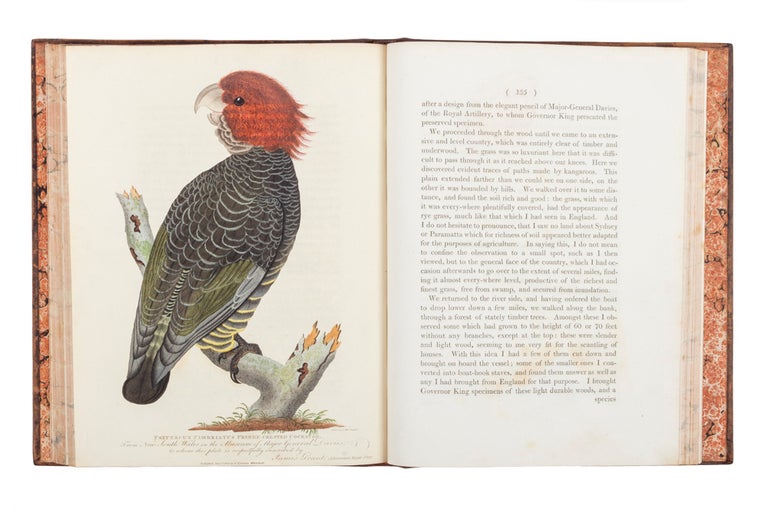The Narrative of a Voyage of Discovery, performed in His Majesty's Vessel The Lady Nelson…
The Narrative of a Voyage of Discovery, performed in His Majesty's Vessel The Lady Nelson, of sixty tons burthen, with sliding keels, in the years 1800, 1801 and 1802, to New South Wales…
London: C. Raworth, 1803.
Quarto, with a large folding plan, chart, coloured plate of a cockatoo and five other engravings including a portrait of Bennelong; complete with the "List of the Encouragers" and the blank leaf; a handsome copy, with wide margins, in contemporary calf, respined to match by Aquarius.
The Lady Nelson and her important early coastal voyages
First edition: a very handsome copy of this desirable work on early Australian coastal exploration.
First edition: a very handsome copy of this desirable work on early Australian coastal exploration.
The Lady Nelson was the first ship to be built with sliding keels to allow closer exploration of shallow coastal waters. James Grant was born in Scotland in 1772; in 1800, as a lieutenant in the Royal Navy, he brought the Lady Nelson to Australia in company with HMS Porpoise. He sailed the unusually designed ship through Bass Strait, the first to do so from the west and, on arrival at Sydney, discovered that he had missed Flinders to whom he was to deliver the ship and was sent back to survey the south-western coast of the continent, assisted by Francis Barrallier. However, because of the lateness of the season, the survey, which took place from March to May 1801, concentrated on Bass Strait and the Victorian coast instead. The chart of Bass Strait here was the first to be published of the newly-discovered Victorian coast.
Over the next two years Grant made several voyages of discovery along the New South Wales coastline but is best remembered for his work in the Hunter River area which resulted in the establishment of Newcastle. Two engravings in this book illustrating the Lady Nelson's exploration of the Hunter were probably engraved after sketches by the colony's first professional artist, John William Lewin, who accompanied the expedition. The beautiful hand-coloured plate of the "Fringe Crested Cockatoo" is present here in particularly fine condition. There are also portraits of the important Aboriginal figures Pimbloy (an alternative spelling of Pemulwuy, the great warrior) "in a canoe of that country" and Bennelong.
This is "a rare book, even more so in fine contemporary condition. It is of the highest significance to any collection of Australian books and no collection of books dealing with coastal discovery or with Victoria can be without it…" (Wantrup).
Provenance: Armorial bookplate incorporating a ship under full sail, with motto "Salvet me deus", but with name removed; with Bernard Quaritch in 1995; private collection (Sydney).
Davidson, 'A Book Collector's Notes', pp. 125-6 ('a rare and most desirable item'); Ferguson, 375; Hill, 718; Wantrup, 75.
Price (AUD): $13,500.00
US$8,816.33 Other currencies




